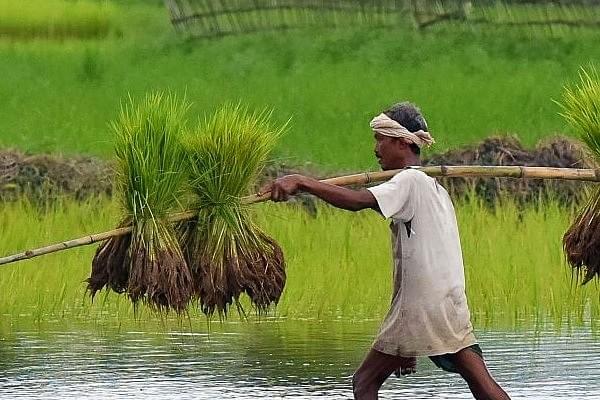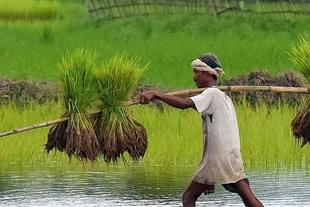Ideas
Challenges And Opportunities For Indian Agriculture In International Context
Dr Subhash Chandra Pandey
Mar 01, 2021, 12:27 PM | Updated 12:27 PM IST
Save & read from anywhere!
Bookmark stories for easy access on any device or the Swarajya app.


In a pandemic-stricken world, time-bound eradication of hunger and malnutrition by 2030 in an environmentally sustainable manner is an international priority and commitment under the United Nations Sustainable Development Goals.
India has offered to use its over-flowing granaries to tackle extreme hunger, but India can do much more and be an agricultural power too. But we are presently tapping into only a fraction of our strength.
Here are some suggestions to achieve this mission.
At a time when misguided environmentalists have aligned with misguided farmers in perpetuating over-production of cereals in an environmentally unsustainable manner, it is apt to recall the report released by UN agencies (FAO, IFAD, WHO, UNICEF, WFP) on State of Food Security and Nutrition in the World on 13 July 2020.
Like most developing countries, India also has witnessed a declining share of agriculture and allied activities in national output in its economic development path.
This share fell from 52 per cent of Gross Domestic Product in 1950-51 to 31 per cent of GDP in 1985-86 and further to about 16 per cent in 2018-19.
Even within agriculture, significant structural changes have taken place, with share of staple crops steadily shrinking and contribution of livestock steadily increasing.
The share of crops has decreased from 65.4 per cent in 2011-12 to 55.3 per cent in 2018-19. So, almost of half of agricultural output is from farming of crops and remaining half from horticulture, milk, meat, fishing, and poultry.
In 2011-12, paddy was the most dominant crop under gross irrigated area having a share of 33.5 per cent followed by wheat (30.3 per cent). This dominance of rice and wheat has intensified use of chemical fertilizers and pesticides and adversely affected groundwater supply.
Diversification from excessive production of cereals to fruits and vegetables, oilseeds and protein diet (both plant and animal origin) is key to rejuvenating Indian agriculture and preparing it to play a bigger role in the international arena as well.
The UN Report has estimated that prior to the Covid-19 pandemic, almost 69 crore people, or 8.9 per cent of the global population, were undernourished and if last five years’ trends persist, the number of undernourished people will exceed 84 crore by 2030 while the goal is to reduce this number to zero under Sustainable Development Goals.
Beyond hunger, a growing number of people have had to reduce the quantity and quality of the food they consume. Two billion people, or 25.9 per cent of the global population, experienced hunger or did not have regular access to nutritious and sufficient food in 2019.
This situation could deteriorate if we do not act immediately and boldly.
Globally, the burden of malnutrition in all its forms remains a challenge. According to current estimates, in 2019, as much as 21.3 per cent (14.4 crore) of children under five were stunted, 6.9 per cent ‘wasted’ and 5.6 per cent ‘overweight’.
The world is making progress, but is not on track to achieve the 2025 and 2030 targets for child stunting and low birthweight, and for exclusive breastfeeding, is on track only for the 2025 target.
While we still face significant challenges in just accessing food, challenges are even more important in terms of accessing healthy diets.
Low-income countries rely more on staple foods and less on fruits and vegetables and animal source foods than high-income countries.
Only in Asia, and globally in upper-middle-income countries, are there enough fruits and vegetables available for human consumption to be able to meet the FAO/WHO recommendation of consuming a minimum of 400 g/person/day.
Shifting to healthy diets can contribute to reducing health and climate-change costs by 2030, because the hidden costs of these healthy diets are lower compared to those of current consumption patterns.
The adoption of healthy diets is projected to lead to a reduction of up to 97 per cent in direct and indirect health costs and 41–74 per cent in the social cost of greenhouse gas emissions in 2030.
However, not all healthy diets are sustainable and not all diets designed for sustainability are always healthy. This important nuance is not well understood and is missing from ongoing discussions and debates on the potential contribution of healthy diets to environmental sustainability.
To increase the affordability of healthy diets, the cost of nutritious foods must come down. The cost drivers of these diets are seen throughout the food supply chain, within the food environment, and in the political economy that shapes trade, public expenditure and investment policies.
Tackling these cost drivers will require large transformations in food systems with no one-size-fits-all solution and different trade-offs and synergies for countries.
Countries need a rebalancing of agricultural policies and incentives towards more nutrition-sensitive investment and policy actions all along the food supply chain to reduce food losses and enhance efficiencies at all stages.
Low levels of productivity, high production risks and insufficient diversification towards the production of more nutritious foods are key drivers of the cost of healthy diets, especially in low-income countries.
Inadequate food storage, poor road infrastructure and limited food preservation capacity, especially for highly perishable foods, lead to food losses and inefficiencies along the food supply chain that drive up the cost of nutritious foods.
Rapid rates of urbanisation have resulted in more work-away and eat-away-from-home habits, with a direct impact on the demand for easy-to-prepare, highly processed foods or convenience foods that are often energy dense and high in fats, sugars and/or salt and do not necessarily contribute to healthy diets.
Addressing low productivity in nutritious food production can be an effective way of raising the overall supply of nutritious foods, reducing food prices and raising incomes, especially for the poorer family farmers and smallholder producers in low-income and lower-middle-income countries.
Insufficient diversification towards the production of horticultural products, legumes, small-scale fisheries, aquaculture, livestock and other nutritious food products also limits the supply of diverse and nutritious foods in markets, resulting in higher food prices.
Diversified and well-integrated production systems not only increase the availability of nutritious foods, but also help vulnerable populations to increase their resilience to climate and price shocks and reduce seasonal variation in food production.
Reducing pre-harvest and post-harvest losses in quantity and quality at the production level in the agriculture, fisheries and forestry sectors is an important starting point to reduce the cost of nutritious foods along the food supply chain. Important causes of losses at the production level include exposure to adverse weather conditions, harvest and handling practices, as well as marketing challenges.
Inadequate storage conditions and decisions made at earlier stages of the supply chain lead to products with a shorter shelf life. Adequate cold storage, in particular, can be crucial to prevent quantitative and qualitative food losses of perishable commodities.
During transportation, good physical infrastructure and efficient trade logistics are of key importance to prevent food losses. Fruits and vegetables and many animal source foods are highly perishable, especially fish, fresh milk, meat and eggs.
Lack of adequate market infrastructure and limited processing technology result in food losses and higher food prices. Improved technology and infrastructure in handling, storage and processing (cool storage systems, cold chains, drying techniques, improved packaging) offers opportunities to reduce losses and lower consumer food prices.
Trade policies affect the cost and affordability of healthy diets by altering the relative prices between imported and import-competing foods.
Protectionary trade measures such as import tariffs, bans and quotas —together with input subsidy programmes — have often been embedded in self-sufficiency and import substitution strategies.
In low-income countries, this policy has protected and incentivized the domestic production of energy-dense foods such as rice and maize, but often at the detriment of vitamin and micronutrient-rich foods (i.e. fruits and vegetables).
Reducing the cost of nutritious foods and increasing the affordability of healthy diets must start with a reorientation of agricultural priorities towards more nutrition-sensitive food and agricultural production.
How to go about agricultural diversification to boost oilseeds, protein and fruits/vegetable production? The farmers are apprehensive about entry of big corporates. How can this concern be addressed?
Out of 14.6 crore operational holdings in 2015-16, 68.5 per cent were less than 1 hectare (Marginal), 17.6 per cent between 1 Ha to 2 Ha (Small), 9.6 per cent between 2 Ha to 4 Ha (Semi-Medium), 3.8 per cent between 4 Ha to 10 Ha (Medium) and 0.6 per cent large holdings above 10 ha.
The small and marginal farmers are certainly going to stay for a long time in India — though they are going to face a number of challenges.
Therefore, what happens to them has larger implications for the agrarian sector in particular and the entire economy in general which, has an implication on people’s livelihood.
Being smallholders, these farmers suffer from some inherent problems such as absence of economies of scale, access to information and their inability to participate in the price discovery mechanism.
The big challenge under these conditions would be to integrate these small holders with the agricultural markets so that benefits from transforming agriculture, trade environment and growing economy may be optimised and help in realizing higher income of small and marginal farmers and lead to more inclusive growth.
The concern now is how to aggregate these smallholders and bring in economies of scale.
The instrument of Farmer Producer Company (FPC) registered under Companies Act is, perhaps, the most appropriate institutional form of aggregation of small farmers. A producer company is basically a corporate body registered as a Producer Company under Companies Act.
Several attempts have been made in the past to aggregate the farmers. One such pioneering attempt was promotion of cooperatives performing various activities in agriculture including input supply. By and large, the experiences of performance of cooperatives has been poor with an exception of co-operative sugar factories and dairy cooperatives in Maharashtra and Gujarat.
Apart from these cooperatives, Amalsad cooperative Society for sapota and farming co-operative (Gambhira) in Gujarat, MAHAGRAPES in Maharashtra, HOPCOMS and CAMPCO in Karnataka, Mulkanoor women cooperative groups in combined Andhra Pradesh etc., have performed well.
There are also a few successful women’s farming groups in Andhra Pradesh. These successful models could not be emulated in other regions of the country.
There are more than 400 such producer companies in India now (SFAC). I think it will be a win-win situation if we scale up aggregation of small farmers into Producer Companies. One good starting point can be ‘Corporatise AMUL’.
AMUL is the backronym for Anand Milk Federation Union Limited, one of the most valuable brands India has created.
We need to reflect on why AMUL became such a grand success in Gujarat, but could not be replicated elsewhere in the country or whether it is time to encash this brand by corporatizing it to unlock further growth potential, by making it international.
(The Author is an IA&AS officer, and superannuated as Special Secretary, Ministry of Commerce and Industry)





